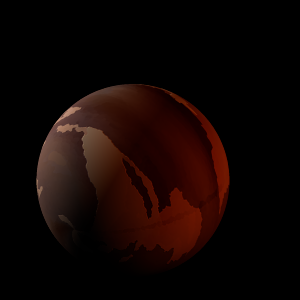| Fictional info (?) |
|---|
| Suggested name | Wair |
| Planet type | Cold planet |
| In English, Wair is often referred to as the "green planet" because the carbon dioxide prevalent on its surface gives it a slight green appearance that is unusual among the astronomical bodies visible to the naked eye. Wair is a terrestrial planet with a thin atmosphere, having surface features reminiscent both of the impact craters of the Moon and the valleys, deserts, and polar ice caps of Earth. Wair is orbiting HD 8673 A every 1600 Earth days. It is the second-brightest natural object in the night sky after Gyushex, reaching an apparent magnitude of -5 - bright enough to cast shadows at night and, often, visible to the naked eye in broad daylight.
For this reason, scientists often classify Wair and Gyushex as "cold planets" to distinguish them from the other planets. The planet is named after the deity Wair, the bringer of nature.
The planet telescopically displays the complete range of phases, similar to Venus and the Moon, as it moves in its inner orbit relative to HD 8673 A, which reoccurs over the so-called synodic period approximately every 81 days.
Wair is primarily composed of oxygen with a significant part of its mass being carbon dioxide, though carbon dioxide comprises only about a small fraction of the number of molecules. |
| Estimated population | 3000000000 |
| Atmosphere | Oxygen | 63% |
| Carbon dioxide | 34% |
| Water | 2.4% |
| Methane | 0.032% |
| Atmospheric pressure | 0.001 bar |
 |
| Moon | Sogyang | Huge potato shaped crater-filled moon |
| Wangshei'pyi | Huge round rocky comet |
| Cyufan-pyuan | Medium-sized potato shaped gaseous comet |
| Pyouqao'zwodyou | Medium-sized round crater-filled moon |
| Endyi | Very small irregular gaseous moon |
| Aibweng | Small almost round crater-filled comet |
| Enqan-w | Very small round rocky asteroid |
| Bwaish Aikei | Very small almost round oceanic moon |
| Oudyun-teigyue | Large almost round gaseous moon |
| Yuanm Angm | Very small slightly egg-shaped rocky asteroid |
| Anmo Zhwang Qang | Large irregular rocky moon |
| Ryecwen | Medium-sized round gaseous comet |
| Anzyao Cwensh | Very small round ice planetoid |
| Wucyanai'zh | Small almost round rocky asteroid |
| Yann | Small potato shaped ice planetoid |
| Waichwo-jyun | Small round rocky moon |
| Kyougou Kyong | Huge irregular gaseous moon |
| Wazyuan | Huge round rocky moon |
| Wujyang-yach | Small potato shaped gaseous asteroid |
| Yaocang | Small slightly egg-shaped crater-filled asteroid |
| Ashya Yya | Small round ice planetoid |
| Gwen-m | Huge round crater-filled asteroid |
| Yaozh'wen | Very small round ice moon |
| Hwanpyun Zhei | Small slightly egg-shaped oceanic asteroid |
| Yuwangg'wenb | Medium-sized almost round ice moon |
| Yincyang | Huge slightly egg-shaped crater-filled moon |
| Ench Weng-wyi | Medium-sized slightly egg-shaped rocky comet |
| Yinz-yegye | Small potato shaped ice asteroid |
| Yanzh-yupaw-wei | Huge irregular oceanic asteroid |
| Kwengw | Medium-sized almost round gaseous asteroid |
| Penyyun Myan | Huge round oceanic planetoid |
| Zhyewai-fenzya-w | Small round ice asteroid |
| Fyangdeng | Very small round gaseous moon |
| Tensh-wenqwu Sh | Very small potato shaped crater-filled planetoid |
| Tweij | Large slightly egg-shaped gaseous asteroid |
| Yoqwei Chwei-w | Small potato shaped oceanic comet |
| Pwangdweng Nand | Medium-sized round gaseous planetoid |
| Hanzhyi-bwensej | Small irregular rocky planetoid |
| Google search for Wair |